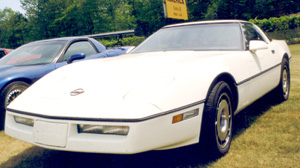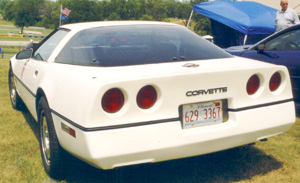
The eagerly-awaited Corvette for the ‘80s missed the start of the 1983 model year. It arrived in the spring of 1983 and gave Vette lovers something to drool over. The aerodynamic car featured an extremely-raked (64-degree) windshield. It had the lowest drag coefficient of any Vette — just 0.341. Testing at GM’s Proving Grounds revealed 0.95G lateral acceleration — the highest ever for a production car. During its model run, orders poured in well ahead of schedule, even though the new edition cost over $5,000 more than an ’82 Vette.
New for ’84 was a series of design and engineering improvements. T-tops gained favor as convertible sales fell. The ’84 Corvette improved on the T-top with a one-piece, full-width fiberglass roof with no T-bar, that could be completely removed. The roof featured a transparent, acrylic lift-off panel. A solar screen designed to keep riders and passengers more comfortable was optional.
Up front, the ’84 sported hidden headlamps, clear integrated halogen fog lamps and cornering lamps. The sport type outside rearview mirrors – one on each side of the car— were electrically controlled. The unit body, with partial front frame, used a front-hinged "clam shell" hood with integral twin-duct air intake. At the rear was a frameless glass back window or hatch and four round tail lamps.
The sole engine used in 1984 was the 350-cid L83 with Cross-Fire fuel injection. This system utilized a pair of throttle bodies on opposite ends of a special manifold. Engineers had found that a 1.81-inch diameter throttle-body was the maximum size that gave good fuel atomization. High-performance engines used more fuel and needed more air flow. The Cross-Fire setup doubled bore area. A complicated electronic control module determined spray timing (in milliseconds) and pulse width. In addition to being complicated, Cross-Fire Injection was prone to wetting the manifold and poor fuel distribution. The throttle bodies also iced up at times and a leaky air intake seal could create havoc.
When operating properly, the Cross-Fire Injection system ups both performance and fuel economy. The L83 was rated for 205 hp at 4200 rpm and 290 lbs.-ft. of torque at 2800 rpm. Using modern technology cures for CFI ills have been worked out and there are many websites for owners of CFI cars.
The ’84 Vette had one of the first fully integrated "designer" engine compartments. Stainless steel headers were used and the air cleaner and valve covers were made of cast magnesium.
A four-speed manual gearbox returned as the standard Corvette transmission, but not until January 1984. A four plus-three-speed automatic with computer-activated overdrive in every gear except first was the other choice – a nocost option. It used a hydraulic clutch. When a console switch was activated, the overdrive was locked out during rigorous acceleration above specified speeds.
Under the chassis was an aluminum driveshaft, forgedaluminum suspension arms and a fiberglass transverse leaf spring. Power rack-and-pinion steering and power fourwheel disc brakes were standard. Optional Goodyear 50-series "uni-directional" tires were new. These were designed so that each tire went on a specific wheel. The Corvette had a 96.2-inch wheelbase and was 176.5 inches long. The body was 46.7 inches high and 71.0 inches wide. Tread widths were 59.6 inches front, 60.4 rear. Size P215/65R15 tires on 15 x 7 wheels were standard and Eagle P255/50VR16s on 16 x 8 wheels were optional.
Inside the ’84 Corvette, an electronic instrument panel featured both analog and digital LCD readouts in either English or metric measure. A Driver Information System between the speedometer and tachometer gave a selection of switch-chosen readings. At the driver’s left was the parking brake.
The standard equipment list included an advanced (and very necessary) theft-prevention system with starter-interrupt, air conditioning, power windows, electronic-tuning seek/scan AM/FM stereo radio with digital clock, reclining bucket seats, leather-wrapped tilt/telescope steering wheel, luggage security shade and side window defoggers.
Corvettes were based price at $21,800 in 1984. They came in colors of White, Bright Silver Metallic, Medium Gray Metallic, Black, Light Blue Metallic, Medium Blue Metallic, Gold Metallic, Light Bronze Metallic, Dark Bronze Metallic and Bright Red. There were several two-tone paint options: Silver and Medium Gray, Light Blue and Medium Blue and Light Bronze and Dark Bronze. Interiors came in Carmine, Bronze, Graphite, Medium Blue, Medium Gray and Saddle.
Corvette production for the year hit 51,547 cars. Of those, 6,443 cars had the late-in-the-year four-speed manual transmission and 3,729 had Delco-Bilstein shock absorbers installed. Only 410cars came with performance axle ratios. An even smaller number of cars – 240 — were factory-modified for use with leaded gasoline so they could be sold in export markets.
March 25, 1983 was the introduction date for the new Corvette and it was immediately a hit with magazine writers. Car and Driver called it "the most advanced production car on the planet."Motor Trend described it as "the best-handling production car in the world, regardless of price.